- Blog
- How Can Limited-Time Offers Boost Your Sales? (10 Examples + Templates Inside)
How Can Limited-Time Offers Boost Your Sales? (10 Examples + Templates Inside)
-
Nikolett Lorincz
- Ecommerce
- 6 min read
Table of Contents
Limited-time offers are a tried and tested way of boosting your sales. They’re effective because of the specific way they increase your customer’s feeling of urgency. This encourages them to act quickly and make a purchase.
But in order for this strategy to work, it’s important to promote limited-time offers the right way. When ecommerce businesses are too pushy with promotional tactics, it usually annoys visitors. On the other hand, if it’s too subtle, visitors may not ever become fully aware of your offer.
In this article, we’ll go over the basics of short-term sales and how to create offers that will make customers feel compelled to buy now rather than later. And we’ll take a look at 10 great limited-time offer examples that you can steal and apply to your business today.
Let’s get started!
What are limited-time offers, and why do they work?
A limited-time offer is any deal available for a set period—from minutes to weeks, often tied to seasonal sales. It can take many forms, like free shipping, a discount code, a free gift, or a BOGO deal.
These offers are often paired with limited-quantity messaging to boost urgency and encourage quick action.
Now let’s break down why they work.
1. They create urgency and scarcity
Limited-time and limited-quantity offers both rely on scarcity—the idea that something won’t be available for long. When shoppers know a deal is about to expire or stock is running low, they’re more motivated to act quickly.
A limited-time offer is any deal available for a short period—from minutes to weeks. It might include free shipping, a discount, a BOGO deal, or a free gift. When paired with limited-quantity messaging, it creates urgency and drives faster decisions.
Scarcity is one of the most influential factors in purchasing decisions, helping move people from casual interest to serious intent.
2. They attract new customers
Online shoppers are naturally cautious, especially with unfamiliar stores. But a limited-time sale lowers the perceived risk. Shoppers are more likely to try a new brand when there’s a discount on the table—especially if it’s only for a short time.
3. They boost loyalty through exclusivity
Limited-time deals can also strengthen relationships with existing customers. Framing offers as exclusive discounts—via email or popups—makes customers feel valued and encourages repeat purchases. Over time, this kind of thoughtful timing can help build long-term loyalty.
4. They reduce cart abandonment
Urgency can be a powerful antidote to hesitation. Exit-intent popups with countdown timers remind shoppers that their opportunity is slipping away—pushing them to complete their purchase instead of leaving your site, and increasing cart abandonment.
As you’ll see in the examples below, this tactic is especially effective when combined with a strong offer and time pressure.
5. They help boost your sales
After all these benefits, it’s no surprise that limited-time offers are also a highly effective revenue driver. Whether you’re targeting first-time shoppers, loyal customers, or both, these deals increase the likelihood of purchase—and that means more sales for your business.
10 limited-time offer examples and templates
Now that we’ve covered how urgency works, let’s look at some real examples of limited-time offers—and how you can use them in your business.
1. Promote free shipping for a limited time
Free shipping is an incredibly powerful incentive for encouraging new and existing customers to make a purchase.
In fact, 88% of online consumers are more likely to buy when free shipping is available.
For example, 1 Body uses an exit-intent popup that offers free shipping specifically when customers are about to abandon their carts.
You would only take on the added expense of offering free shipping at the time that a customer needs a final push to make the decision and complete a purchase. This would not affect customers who want to move directly to the checkout page.
The fifteen-minute countdown clock also leads to more sales by establishing a very limited period of time that the offer is valid for.
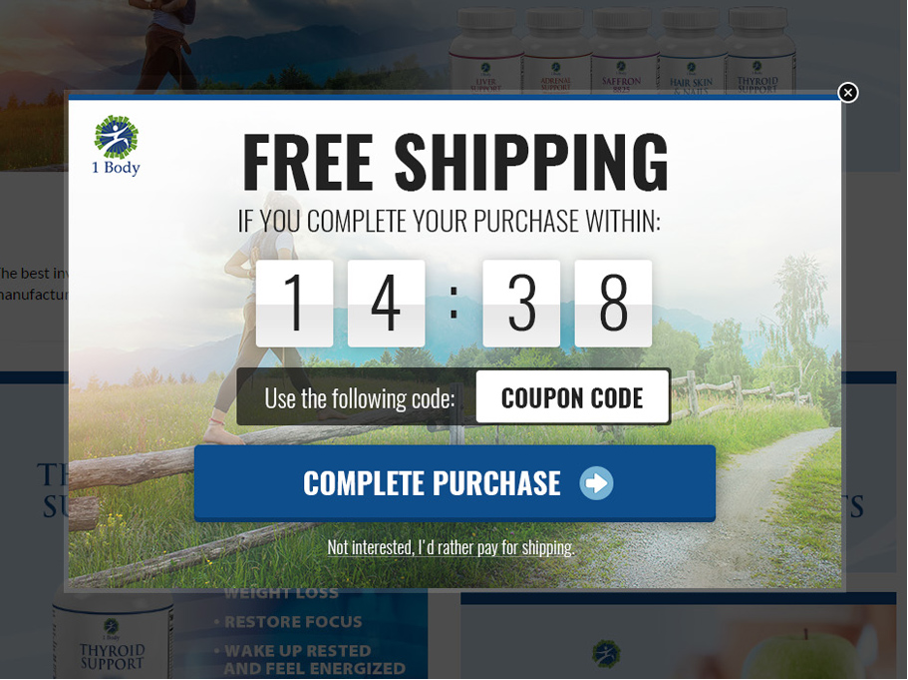
2. Promote a free gift
A free gift is another limited-time incentive that you can make use of if it’s not in your fiscal plan to offer free shipping.
Sending out free samples and products also helps with customer retention. People feel valued and like the opportunity to try out products that they may end up loving and then decide to buy in the future.
You can offer gifts for a “limited time only,” like in the example below, or use a limited-quantity message such as “while supplies last.”
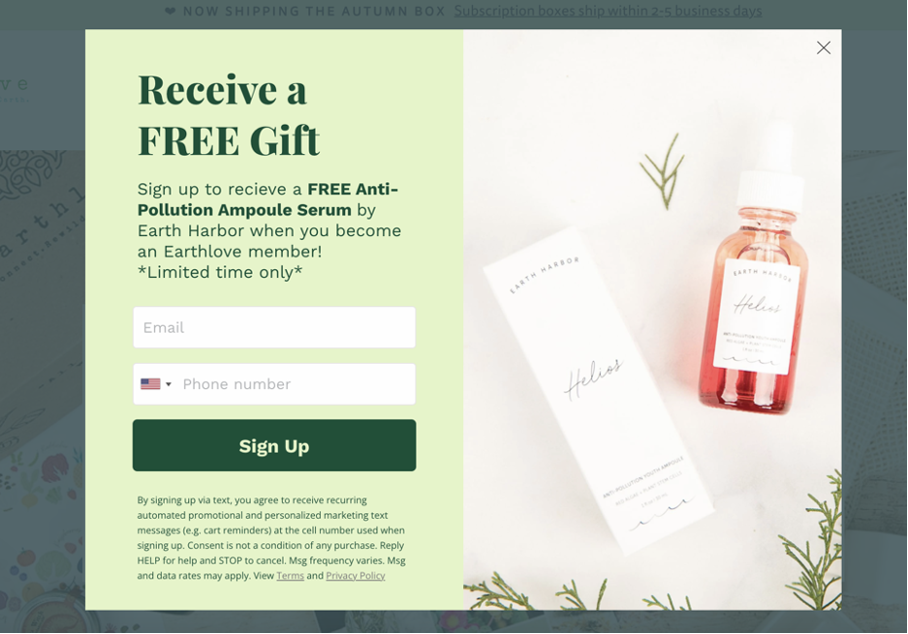
3. Use a limited-time offer to stop shoppers from abandoning their carts
Another way to stop cart abandonment is by displaying a popup with a percentage discount that’s only available for a short time.
The copy below has a nice touch with the “EXTRA 15% off!”, because it sweetens the deal.
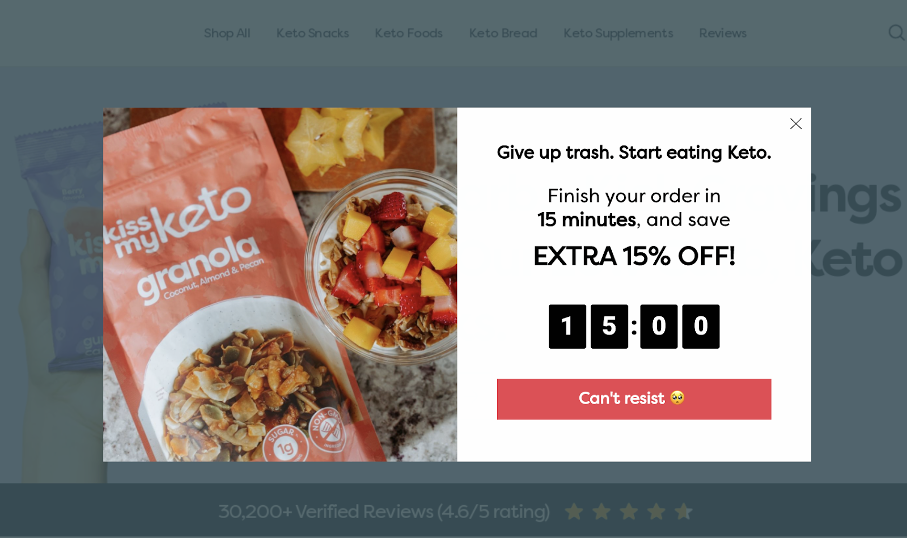
If you’re ready to get off the “cart-abandonment struggle bus,” OptiMonk has got you covered with lots of popup templates that you can have up and running in minutes.
Check them out below:
4. Use countdown timers
The addition of a countdown timer is a great way to get customers to act fast.
The sight of a timer ticking down, second by second, is one of the best psychological triggers that can be used to create a sense of urgency. There’s a reason why so many Hollywood movies use a ticking timer on a bomb to get characters moving quickly, and it also creates thrilling suspense.
The example below is highly effective because it uses two different limited-time messages—the “only today” copy and the countdown timer, which shows the remaining hours and minutes of the current sale.
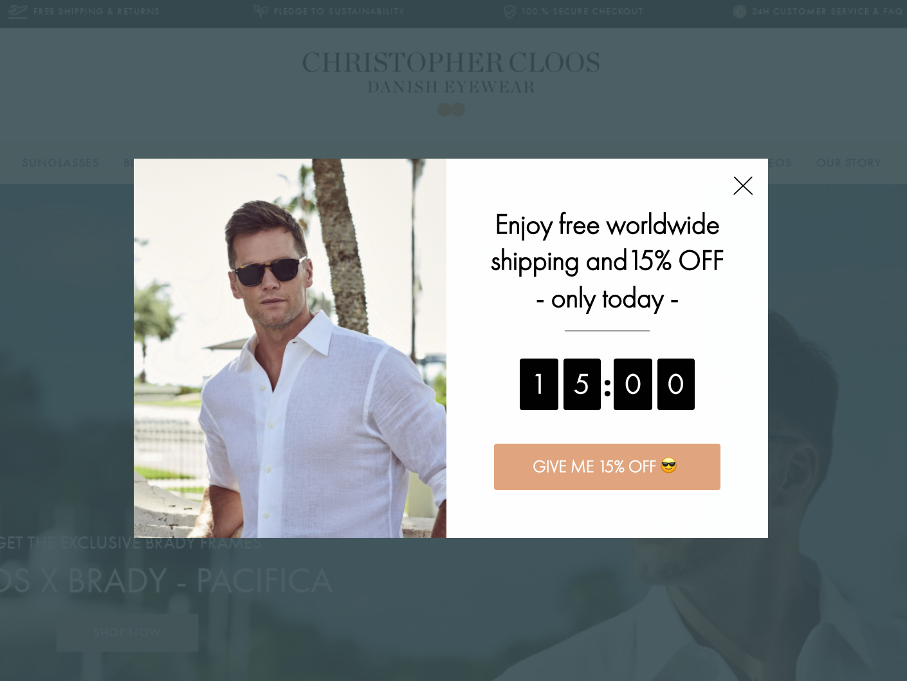
You can add a countdown timer to a sticky bar too:
5. Leverage the holiday season
Seasonal sales are a natural place to use limited-time offers to boost sales because they have a built-in expiration date. The Halloween Giveaway in the example below is over once the calendar passes October 31st.
Since most customers already know when Halloween is, they’ll be able to remember the date of when the sale ends on their own, and plan their purchases accordingly.
When you consider the huge interest that customers have during certain holidays (Christmas and Black Friday—the two biggest), you can see why seasonal sales can generate tons of revenue.
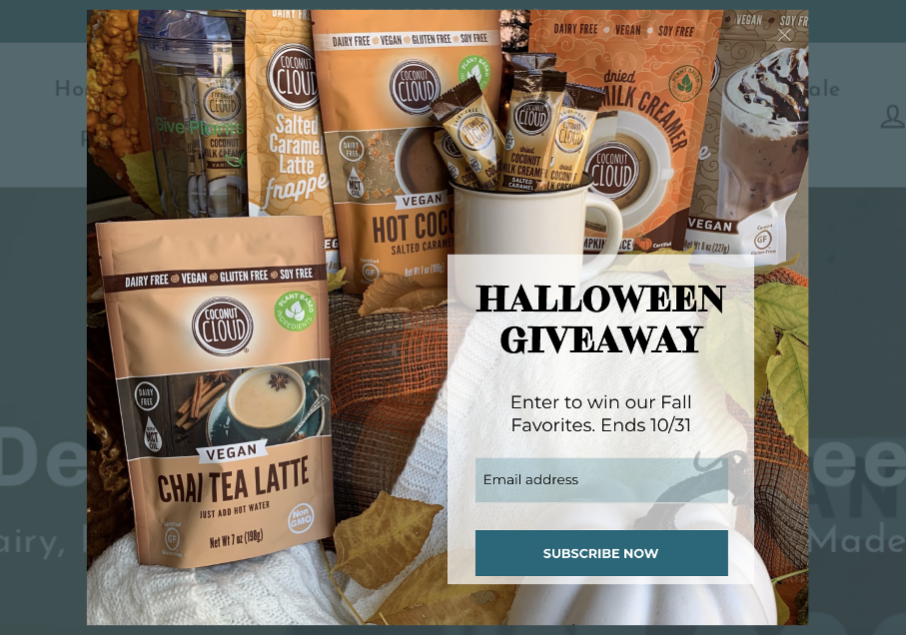
Whatever the holiday or season, OptiMonk has a popup template that’s been specially designed to promote the special offers that your customers love to see:
6. Build your list for an upcoming limited-time sale
The lead-up to a limited-time sale is a great opportunity to build strong email and SMS lists. You can promise subscribers that they’ll receive special deals or early access to your sale.
The fact that the upcoming sale will be for a short period of time, means that prospective customers will plan ahead for it.
See how the example below displays a message that only subscribers would “be notified first” about their upcoming Black Friday deals:
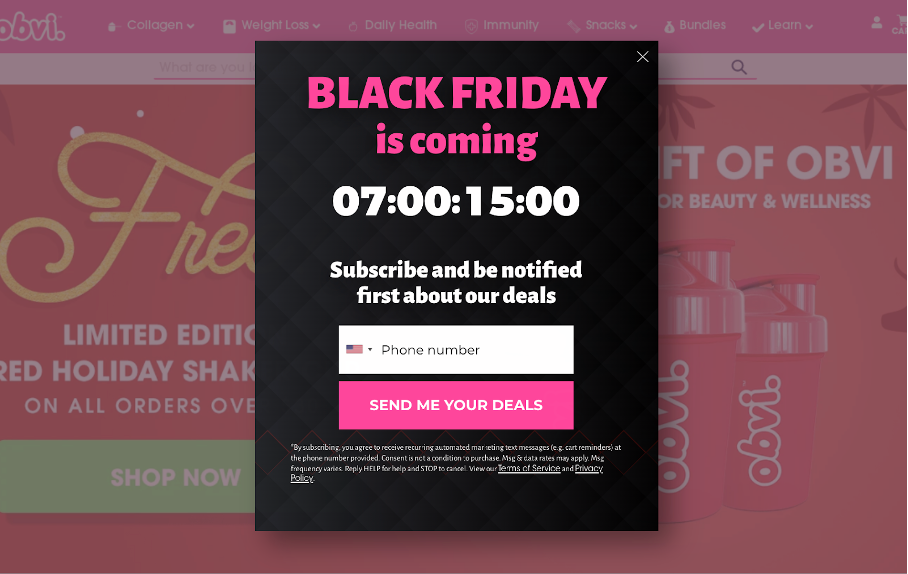
7. Promote products with limited inventory
If you don’t have the budget to offer lots of discount options, you can still create a sense of urgency and increase your customers’ fear of missing out (FOMO) by highlighting limited inventories.
You could also try offering limited edition products that won’t be around forever or show a live countdown of how many you have left.
Here are some effective templates that can help you clear out the inventory you want to sell. You can use them to display your most exciting limited-edition products.
8. First-time purchase offers
Online store owners are always confronting the problem of high bounce rates and not enough first-time visitors entering their sales funnel.
Limited-time offers for first purchases are a great way to ensure that more visitors make it from your landing page to your checkout process.
You can also take advantage of your limited-time promotion by getting visitors to join your email list. That way, you can send them future offers as well.
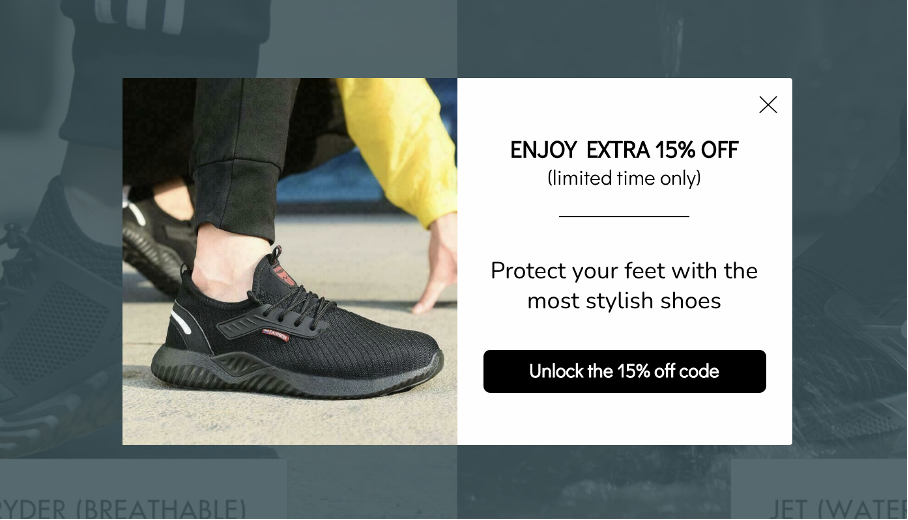
9. One-day offers
A “single day event” is another good time frame for both limited-time offers and flash sales. Choose to run your campaign from any time period, ranging from just a few hours to a full 24-hour period. There’s still urgency involved, but customers will feel a little less pressure than when they’re confronted by a countdown timer.
Best Buy became famous for their daily deals because they showcase a large discount on a different product each day. It’s a great example of how to get customers accustomed to checking back for daily deals.
Let’s look at another example:
BiBado, a childcare ecommerce brand, uses a similar idea with their “Save £10 when you spend £25 or more today!” The one-day time limit encourages customers to make a purchase right away.
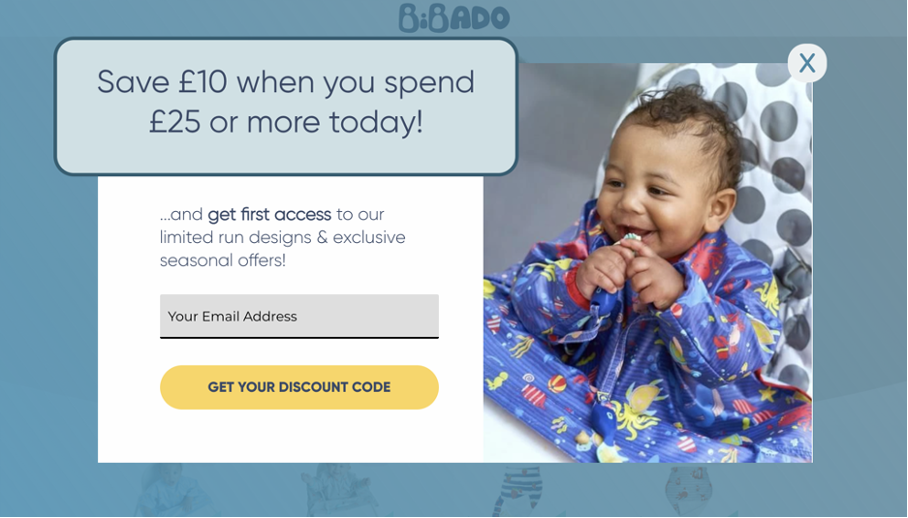
10. Create sticky bars to remind visitors
Sticky bars are a great tool for promoting your limited-time offers across your entire site.
They’re always on your customers’ screens. But they don’t interrupt their shopping experience in the same way as popups, because they float only on the top of the website.
How to create successful limited-time deals?
Now that we’ve explored various limited-time offer examples, let’s dive into the practical steps you can take to create your own successful campaign.
Following a structured approach can ensure your offer not only grabs attention but also drives meaningful results.
Here’s a step-by-step guide to help you get started:
Step 1: Define your goal
Start by identifying what you want to achieve with your limited-time offer. Do you want to clear inventory, boost revenue during slow periods, or attract new customers?
Clearly defined goals will guide your strategy and help measure success.
Step 2: Choose the offer type
Select the type of limited-time offer that aligns with your goal. Make sure it resonates with your target audience. Here are some options:
- Flash sales: Short-term discounts to create urgency.
- Buy one, get one (BOGO): Encourage higher purchase volumes.
- Holiday specials: Tap into seasonal buying behavior.
- Free shipping: Lower the purchase barrier.
- Mystery discounts: Add an element of surprise and excitement.
Step 3: Set a clear timeframe
The timeframe is crucial in limited-time offers. Aim for short durations, typically 24-72 hours, to create urgency. Use countdown timers prominently and align your offer with specific dates or events for added relevance.
Step 4: Promote the offer
Effective promotion ensures your audience knows about the deal. Use multiple channels:
- Capture the attention of website visitors with strategically placed popups.
- Send targeted emails to your subscriber list.
- Leverage platforms like Facebook, Instagram, and Twitter to reach a broader audience.
- Partner with influencers to spread the word.
Combining these methods maximizes your reach and engagement.
Step 5: Monitor and adjust
Tracking the performance of your offer is essential.
Measure the increase in sales volume and gather insights from customers on what worked and what didn’t. Analyze the effectiveness of different promotional channels by looking at conversion rates and ROI.
Regular monitoring allows you to fine-tune your strategy for future offers.
4 common mistakes to avoid
Limited-time offers work, but a few common mistakes can hurt your results or credibility. Here’s what to watch out for.
1. Overusing urgency
Urgency is powerful—but only when it feels real. If every campaign is labeled “limited-time only,” your audience will quickly tune it out. Use urgency sparingly, and save it for offers that genuinely have a short window or limited quantity.
Otherwise, it loses credibility and effectiveness over time.
2. Vague deadlines
Saying “offer ends soon” doesn’t trigger real urgency—it creates confusion or skepticism. Instead, be specific: “Ends in 3 hours” or “Valid until Sunday at midnight” gives customers a clear decision window.
The more concrete the deadline, the more likely they are to act on it.
3. Not matching the offer to user intent
A limited-time offer that isn’t relevant to the visitor’s needs or journey will fall flat. For example, showing a BOGO deal for a product they’ve never viewed—or a discount on something unrelated to their cart—misses the mark.
Make sure your offer aligns with where the user is in the buying process.
4. Skipping A/B testing
Just because a limited-time offer worked once doesn’t mean it’ll work again. Different timing, audiences, and formats can drastically change results.
A/B testing variations—like headline, time window, or offer type—helps you optimize for what actually drives conversions.
FAQ
What is a limited-time offer?
A limited-time offer is a promotion or discount that is available for a short, specific period. It creates a sense of urgency, encouraging customers to make a purchase quickly before the deal expires.
What is another way to say “limited-time offer”?
Other terms for a limited-time offer include “flash sale,” “time-sensitive deal,” “short-term promotion,” “special offer,” and “exclusive discount.”
How do I advertise a limited-time offer?
To advertise a limited-time offer, use multiple channels, including website popups, email marketing, social media, and influencers.
Summing up
If you want more customers to complete your conversion funnel, a limited-time offer is one of the best ways to do so.
Whether you’re running a huge semi-annual sale or quick flash sales, popups are the most sure-fire way to ensure that your customers see your limited-time offers. And don’t forget about using the power of a limited-time offer to stop cart abandonment!
Why not try out one of the limited-time offer popup templates on your site and drive sales now?
Migration has never been easier
We made switching a no-brainer with our free, white-glove onboarding service so you can get started in the blink of an eye.
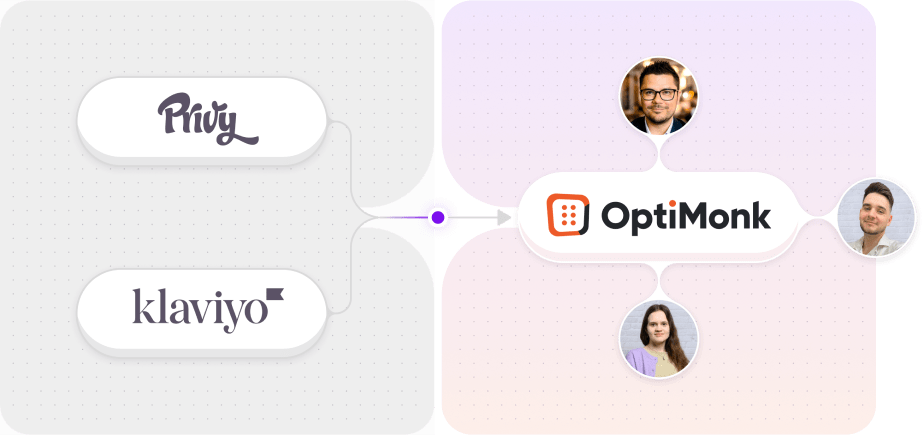
What should you do next?
Thanks for reading till the end. Here are 4 ways we can help you grow your business:
Boost conversions with proven use cases
Explore our Use Case Library, filled with actionable personalization examples and step-by-step guides to unlock your website's full potential. Check out Use Case Library
Create a free OptiMonk account
Create a free OptiMonk account and easily get started with popups and conversion rate optimization. Get OptiMonk free
Get advice from a CRO expert
Schedule a personalized discovery call with one of our experts to explore how OptiMonk can help you grow your business. Book a demo
Join our weekly newsletter
Real CRO insights & marketing tips. No fluff. Straight to your inbox. Subscribe now
Nikolett Lorincz
- Posted in
- Ecommerce
Partner with us
- © OptiMonk. All rights reserved!
- Terms of Use
- Privacy Policy
- Cookie Policy
Product updates: January Release 2025








